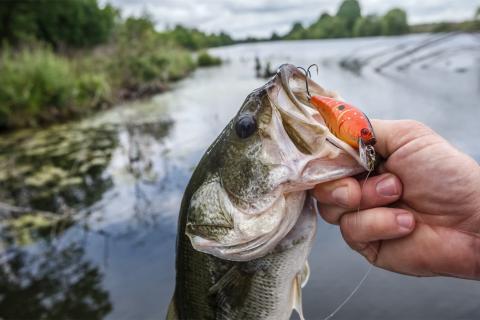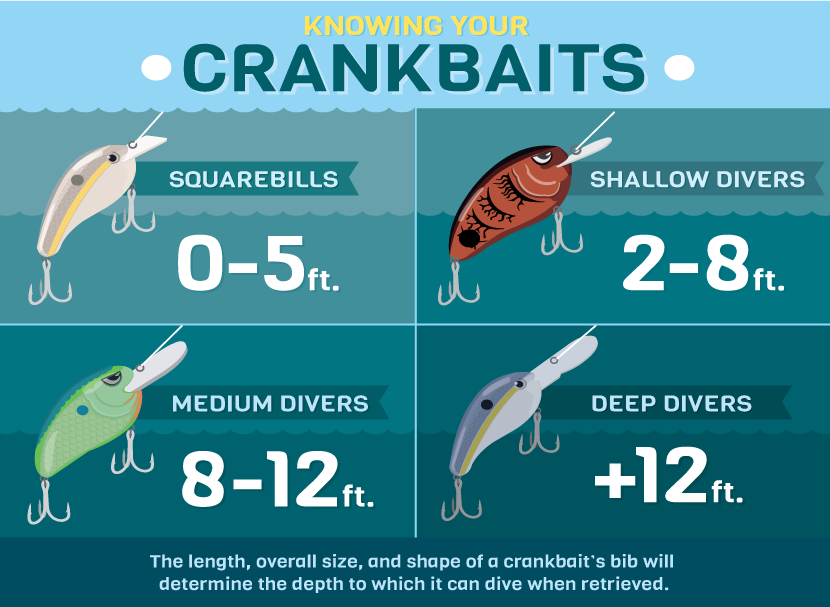
In March, April, and May, game fish of all species move out of deep holes into shallow water, setting the stage for some of the best sport fishing of the year. Few fishing lures can hold a candle to crankbaits for cashing in on this shallow water, spring fishing action.

Bass, smallmouths, pike, stripers, walleyes, hybrids, bluegills, crappies, pickerel, muskies, white bass—take your pick. Almost all gamefish that invade thin water in spring can be enticed with today’s high-tech crankbait offerings. For pure dawn-to-dark action and the added chance of latching onto the trophy of a lifetime, tie on one of these diving, wobbling plugs. Then pitch it out, crank it down, and hold on tight!
Just how good are crankbaits at catching fish? Kevin VanDam, who has won over $6 million in fishing tournaments, said a square bill crankbait has been more important in accomplishing these wins than any other single lure. John Crews, another well-known pro, lists a flat-sided crankbait as his “go-to” lure for catching the most bass and heaviest fish in tournaments.
Watch Video: Selecting Square Bill Crankbait Colors for Spring With KVD
Tip: Not only are crankbaits the single most reliable lure you can turn to for spring fishing; they are custom-made for the newcomer or moderately experienced angler. Though fishing pros have all kinds of special tricks for drawing more strikes, one of the best ways to fish these lures is to toss them towards likely spots and reel them back. Nothing could be simpler.
Extra Tip: While chucking and reeling works, be sure to vary the speed of your cranking. Some days fish are aggressive; other days, they want a slowly wobbling lure.
What Size Crankbaits to Use

In choosing crankbaits for spring, you should consider a variety of factors. One of the most obvious is size. Cranks range from the inch-long Bass Pro XTS Micro Light Mini Crankbait and to the popular Yo-Zuri Snap Beans crankbait to models half a foot or more long. Match your selection to the size of the quarry, line diameter, and size of waters you’re fishing. A creek or pond demands smaller lures in general than a large impoundment with 10-pound bass lurking in it.

At this time of year, most forage fish are large, so opt for medium to big plugs for most situations. Young of the year, baitfish won’t be abundant for another few months.
Tip: Fish are often sluggish from the cold in early spring, so a medium to big plug is most likely to stir them into wanting to chase it down for a high-calorie meal.
Tip: For most early spring all-around fishing and bass angling, a crankbait in the 2-3 inch size is the best bet. For muskies, northern pike and stripers, opt for larger sizes--4-6 inches.
What Color Crankbaits Work Best

Color deserves careful thought. Often lures that match the color of the dominant food perform best. The primary food they like is typically a shade of silver, but sometimes gold. For murky conditions, go with bright fluorescent hues such as chartreuse, orange, yellow, or the famous “fire tiger” pattern. Crankbaits with black, blue, and purple in them can also be productive.
Tip: Silver underside and black back like the popular Bass Pro Shops XPS Lazer Eye The Egg is a standby that every angler should have in their tackle boxes.
What Shape of Crankbait to Choose
There are no hard-and-fast rules when it comes to shape consideration for crankbaits. The best approach is to be aware of the wide variety of crankbait shapes available and stock a selection in different sizes. Some anglers prefer flat-sided crankbaits while others favor a moderately rounded shape. Some like the super fat-bellied type of plugs such as the Bomber Shallow A - Oxbow or the very popular Bass Pro Shops XPS Lazer Eye The Egg. Walleyes often seem to prefer elongated crankbaits such as the Rapala Shad Rap.

Tip: Pay attention to lip shape, too. Vandam prefers square-billed baits that can “ricochet” off rocks and logs, inciting instinctive strikes.
Tip: A variety of crayfish-shaped crankbaits are also available, such as the Rebel Crawfish, sold by outlets such as Bass Pro Shops. Other sizes are super-small crankbaits that can imitate aquatic insects, such as the Yozuri Snap Bean.
How Shallow do Crankbaits Dive?

How shallow should your crankbait dive? The shallow dive depends almost entirely on the depth of the water. Most cranks perform best when they run within a few feet of the bottom or scrape the lake floor periodically. Since gamefish are mostly in thin water now, models that probe the one to the five-foot range are best.
Tip Shallow Crankbaits: Divide these into two types for further specialization. For fish that are extremely shallow, go with offerings such as Mann’s 1-Minus crankbait. These can be worked over sunken brush and weed beds without hanging up and are great spring producers. For slightly deeper conditions and a more extensive application, go with plugs that run two to five feet deep.

Source: Fix.com Blog
Fish Crankbaits That Rattle or Not?

Shad Kit
More and more companies offer crankbaits with rattles or shot inside that bang together and produce extra noise. These are great in spring because you want to stir fish into striking, and these fish sometimes still a bit sluggish from winter or are more concerned with starting the spawning ritual than feeding.
Tip: For skittish fish, small waters and light lines, stock some non-rattling baits.
Why Kind of Retrieve to Use on Crankbaits?
For much crankbait fishing, simply casting to shallow cover such as rocks, stumps, docks, flats, weeds, pilings, and logjams pays off with a steady, moderate retrieve. Sometimes it pays, though, to crank the bait down deep, then slow the reeling just enough to get the right action from the lure. A final speed is ripping the bait as fast as you can without destroying its effect.
Tip: Sometimes, the stop-and-go methods are worth trying. Reel a few feet, then pause, reel again, then pause. This method realistically imitates the scurrying motion of real crayfish and the darting action of baitfish schools.

Speed Stick Casting Rod
Tip: Try to time your pause when the lure is right next to prime cover such as a rock or log.
What Rods are Good for Crankbaiting?
Stiff rods with fast recover rates (straightening after being flexed) are great for plastic worms and jigs. For crankbaits, though, these rods hinder hookups because they do not flex enough and can pull the hard bait away from the fish’s mouth. The best rod for this fishing has a more flexible, softer tip, but plenty of backbone like the Lew's David Fritts Perfect Crankbait Speed Stick Casting Rod for wrestling hooked fish out of thick cover.
4 Tips on Special Fishing Tricks for Crankbaits
1. Choose the Wrong Depth Lure

crankbait. Big crankbaits often stir earlyin spring because there are no “young of the year” baitfish around yet.
If bass are proving uncooperative, try this trick: choose a crankbait designed to run deeper than the water you are fishing. The lure will burrow into the bottom debris and leaves, kicking up a fuss like a scurrying crayfish as it bounces and ricochets off rocks and rubble. If the water is eight feet deep, for example, use a plug designed to run 10-15 feet.
Cast the lure past the area where you expect fish to be, so you can crank it down to the bottom before you reach the cover.
Hold the rod tip low to the water or even submerged in it to help the plug dive quickly.

Reel fast and steadily and work the bait across and into the bottom in a stop-and-go, staccato fashion. Both crayfish-shaped and regular minnow-profile baits work well for this approach. The aggressive presentation and bottom stirring commotion are what triggers strikes.
2. Stop and Wait
Many anglers pause briefly during their retrieves. But try this trick. Stop reeling and let the lure slowly drift back to the surface, or hover for long seconds in front of fish if it’s a suspending model. Fish don’t see this action very often, and it’s a useful ploy on hard-pressured waters.
3. Skip It

Chautauqua Lake in New York.
Try pitching or skipping crankbaits far back under boat docks. You’ll break a few lures, but this is often the best way to trigger aggressive fish into striking. You can even bend the eyelet of the fishing lure slightly to one side with pliers to get it to run towards the pilings and knock against them, inciting reaction strikes.
4. Add a Trailer to Your Crankbait
When action is slow, add a small plastic twister tail or piece of worm to the rear treble hook. Adding the twister tail or worm gives the lure extra bulk, and a different look and action than fish have seen. It’s particularly deadly for walleyes and stripers.
Sometimes just casting and reeling is all you need to do with crankbaits to get plenty of rod-bending action. But when fish are a bit more skittish or close-mouthed, try these special tricks and see if they don’t improve your catch rate and the size of fish you hook.
Watch Video: How to Tune a Crankbait by Ott DeFoe
How to Tune Crankbaits, How to Get Crankbaits Deeper, how many crankbaits do I need?,
- 6245 views

